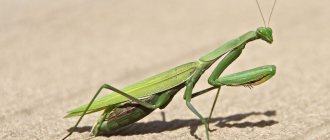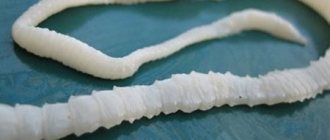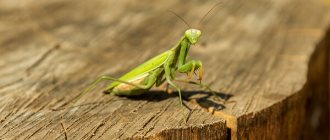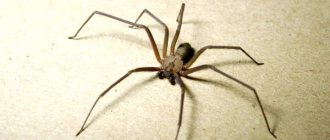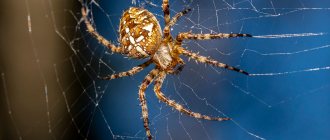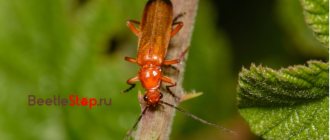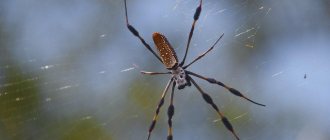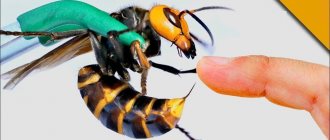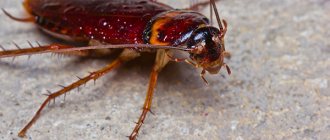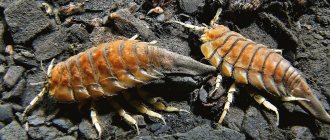Many people have heard that the female praying mantis eats her partner after the wedding night. If the praying mantis can eat its fellows, there are concerns that the predator also poses a threat to humans.
The life and habits of praying mantises are surrounded by mysteries and legends. They are fed not only by other species of living creatures, sometimes twice as large, but also by relatives. Next we will talk about these amazing insects to understand how the praying mantis can be dangerous and useful for humans.
Description and habitat of the praying mantis
The body structure of praying mantises is very unique. The belly is very elongated. The triangular head has a semblance of a neck and is very mobile.
The praying mantis can turn its head almost 3600. 5 eyes on the head (2 faceted and 3 unpaired between the antennae) make vision the main sense organ of this insect.
Antennae can be of different shapes and lengths; this is one of the characteristics of the insect species.
The wings of males are well developed. Females, as a rule, are much larger than males, and their wings are less developed; they fly close and reluctantly.
The hind limbs - long walking legs - allow you to always keep the body above the ground. The grasping forelimbs are equipped with sharp spines for holding prey.
The praying mantis is a diurnal hunter, capable of hiding for hours, merging with the surrounding landscape. Attack the victim from behind with lightning speed and immediately start eating. Only living creatures are suitable for praying mantises. No matter how hungry the predator is, carrion does not flatter him.
Praying mantises live almost everywhere, with the exception of the northernmost territories of the planet.
They feed mainly on insects. Among other things, praying mantises eat parasites such as aphids, flies, and mosquitoes, thereby benefiting humans.
Interesting! Why does the female praying mantis still eat the male? By the way, this is not always the case. And everything is explained simply: to produce eggs, the female needs additional protein, which she literally receives from her partner’s body.
Features of reproduction
In general, females are very aggressive, especially during the mating season. They even attack each other. The loser becomes food for the winner.
At first, the male is of interest to her only as prey. But driven by instinct, he tries in every possible way to attract her attention. To do this, the mantis performs a kind of dance in front of the female, which then ends in death for him.
The great need for protein for the formation of eggs forces the female to eat even the male. This sometimes happens right during mating - she bites off her partner’s head. But more often he does this afterwards, eating it whole.
The female lays eggs in special capsules of a protein solidified substance called ootheca. From 10 to 400 eggs lie in rows in it. Ootheca is very durable and can withstand even frosts. In some areas, the eggs remain there all winter.
What danger do praying mantises pose to humans?
Despite its predatory disposition and aggressive behavior, it cannot be said that the praying mantis is dangerous for the king of nature - man. The praying mantis does not consider such a large object as prey.
One of the common myths about the praying mantis is that its bite is poisonous to humans. However, we can say with confidence that poisonous mantises do not exist in nature.
Is the Crimean mantis dangerous?
The Crimean mantis, or rather mantis (Ameles taurica), was first described by entomologist Vasily Yakovlev, who lived in Crimea, in 1903. There is still debate about which genus of true mantises this type of insect should be classified as. Found in steppe regions:
- on the western tip of the Crimean Peninsula (in the area of Lake Jyrylgach);
- in the south of Ukraine (Kherson and Zaporozhye regions);
- some time ago he was seen in the Temryuk district of the Krasnodar region.
Coloring in shades of sandy-brown allows the Crimean mantis to remain unnoticed when hunting. Well-developed transparent wings with noticeable brown veins make them good fliers; insects are able to make long flights in search of the best place for feeding.
The female has a size of 22–27 mm, males are smaller. Females have shorter wings, with a dark purple spot in the middle, and a more rounded abdomen.
The available data on Crimean mantises from the point of view of danger to humans allows us to say unequivocally: no.
Speaking of which! On the territory of Crimea there are several more species of praying mantises, which are found in different areas. However, none of them received the name Crimea anymore:
- common mantis with an elongated green body, 7–10 cm long;
- Bolivaria with short wings (wormwood) is dark gray, 3.5–5 cm in size;
- striped empusa - larger than the previous species, 4–6.5 cm, elongated body, alternating green and yellowish stripes in color. Listed in the Red Book.
History of the name
People have known about praying mantises for a long time, but they were not studied in detail for a long time. Ignorance continued until the authoritative naturalist, member of the Academy of Sciences in Paris, Swede Carl Linnaeus, spoke about these amazing creatures more than 300 years ago.
In the written work “System of Nature”, the scientist gave insects their current names, the hero of the article was given the name from two words
-
God and prayer
. Why the author gave this name is now a mystery. But there is an opinion that this name was given because of the front legs, often folded as if the creature was praying. In 1758 the name "mantis" was given.
Zoologists were able to establish a habitat that includes most of the globe. They have a year-round cycle, do not hibernate and do not reduce their activity. Their lifespan is short, they live on average about a year
and during this time they grow up, hunt, lay offspring and die.
Is a mantis bite dangerous?
For an adult, a mantis bite is most likely not dangerous. Praying mantises are not poisonous, as mentioned above, they do not tolerate any infection, their saliva does not cause an allergic reaction in humans and animals.
What a mantis bite can be dangerous for a person is that it will cause itching on the skin for 10-15 minutes. Fortunately, the itching disappears quickly and without a trace.
In addition, the mantis can pinch a person's toes and damage the skin with thick spines that serve to catch and hold prey.
These injuries do not pose a threat to life and health and quickly disappear without any intervention.
Diet
The common mantis is not a typical herbivorous insect, but is classified as a carnivore. It is capable of sitting in ambush for a long time, and then suddenly attacking its prey, which is larger than the insect itself in size.
The praying mantis diet contains:
- bees;
- butterflies;
- beetles.
Larger representatives attack frogs, small rodents, and small birds. Praying mantises can eat their relatives, this is especially true during the mating season and the drinking period.
Interesting!
Cases of attacks by praying mantises on hummingbirds, frogs and lizards, and mice have been recorded more than once.
For some animals, beetles themselves are food; they are hunted by birds, snakes, bats, as well as mantises themselves.
Precautionary measures
However, it should be remembered that an attack and bite from a praying mantis can be dangerous for children, especially young ones. Children, thanks to their curiosity and restlessness, can hunt these funny insects. An aggressive or frightened mantis may attack and harm your baby:
- A child can be very frightened if he is attacked by a large, rather scary-looking insect.
- The praying mantis more often injures the thin skin of children than the skin of adults.
Therefore, while in the wild, you should carefully look around so as not to accidentally disturb a praying mantis that is hunting or in the process of mating. It is necessary to explain to children that they cannot catch insects and hunt them.
Pest Control
The use of praying mantises as a form of biological pest control is becoming increasingly common. Spraying pesticides in the garden, the environment is increasingly viewed more negatively by people.
They are known to be quite big eaters. They feed on small pieces of aphids, worms, and hornets. But be careful, the mantis will also eat beneficial insects, such as ladybugs. It is recommended to use it to control large pest infestations.
Mantises are completely carnivorous; will eat almost any insect that is small enough to be caught. Juveniles chase small insects, while adults eat flies, wasps, cockroaches, butterflies, cicadas, crickets, moths and even spiders. One adult can eat up to 25 flies per day.
According to ancient legend, if a praying mantis sat on a woman, it was a sign of conception. Based on the gender of the insect, they predicted whether the child would be a boy or a girl.
Enemies in nature
Although praying mantises are excellent predator hunters, they themselves can also become prey for snakes, some birds or bats. But the main enemies of mantises, perhaps, are their own relatives - other mantises. Fights to the death between two rival mantises are not uncommon. The fights themselves, both between praying mantises and with other insects, are very spectacular; first of all, the praying mantis seeks to scare its opponent, for this it takes a special frightening pose - it throws its front paws forward and lifts its belly up. All this may be accompanied by corresponding threatening sounds. Such a demonstration of strength is by no means feigned; mantises are desperately brave and bravely rush even at a much larger opponent. Thanks to such courage and bravery, mantises often emerge victorious from such fights.
Living conditions
During the stages of its development, the praying mantis tends to shed its skin, thus increasing in size. For individuals that have just been born, a small container will be an excellent home, but for teenagers you can use a jar or something similar in size. The temporary housing of young mantises should be covered with film, after making a hole in it for feeding. A necessary condition is the presence of branches in the container, which should be exactly three times larger in size than the young growth.
Reproduction
In warm climates they breed throughout the year, in temperate climates - in the fall.
The male carefully approaches the female, performs a mating dance and begins mating. At this time, the female can bite off his head and eat him
. Or she can eat it afterwards. She does this in order to replenish protein reserves in the body, which she needs to breed offspring. But some males can escape in time and survive.
After some time, the female lays eggs, enveloping them with a special sticky substance, and after 1-6 months wingless larvae hatch from them. After several molts, these larvae develop into adults.
After some time, the female lays eggs, enveloping them with a special sticky substance, and after 1-6 months wingless larvae hatch from them.
